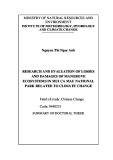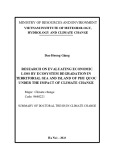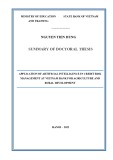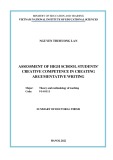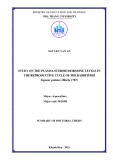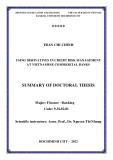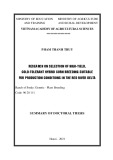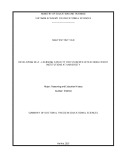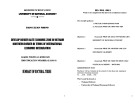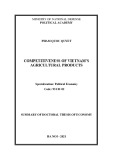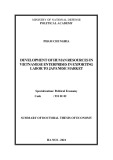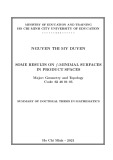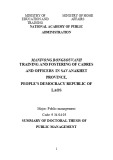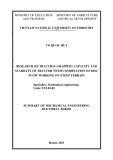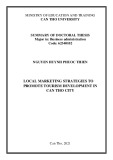MINISTRY OF EDUCATION AND TRAINING VINH UNIVERSITY LÊ DUY LINH RESEARCH ON THE COMPOSITION OF ESSENTIAL OIL- BEARING PLANTS SPECIES IN VU QUANG NATIONAL PARK, HA TINH PROVINCE Major: Botany Code: 9 42 01 11 ABSTRACT OF A THESIS DOCTOR OF PHILOSOPHY IN BIOLOGY VINH, 2020
This thesis was fulfilled at Vinh University
1. Assoc. Prof. Dr. Pham Hong Ban 2. Assoc. Prof. Dr. Tran Minh Hoi
Supervisors: Reviewer 1: Reviewer 2: Reviewer 3:
The thesis will be defended at Vinh University
The thesis can be found at: The National Library of Vietnam Library of Nguyen Thuc Hao
INTRODUCTION
1. Rationale
Located in the tropical monsoon region, Vietnam is ranked in the sixteenth in the world in terms of biodiversity. According to the record and description in the “Indochinese General Plant” (Flore Générale de l’Indochine) and its subsequent collections, there are over 240 families with over 7,000 vascular plant species. In recent years, many botanists have predicted that the figure could reach over 12,000 species. Currently, there have been about 10,500 species of vascular plants, of which about 657 species belonging to 357 genera and 114 families containing essential oils (accounting for about 6.3% of total species; 15.8% of total genera and 37.8% of total families).
Along with the development of the society, the need to learn and to use compounds of natural origin is increasing. Among the plants that are considered as an important resource, those plants containing essential oils play an important part. This is an essential source of many industries such as cosmetics, food and pharmaceuticals, etc. Most essential oil-bearing plants are in the two branches of Pinus (Pinophyta) and the Magnolia (Magnoliophyta). The family which have many species of essential oil plants include Cúc (Asteraceae), Cam (Rutaceae), Na (Annonaceae), Long não (Lauraceae), Bạc hà (Lamiaceae), Hoa tán (Apiaceae), Hoa hồng (Rosaceae), Dầu (Dipterocarpaceae), Nhài (Oleaceae), Thông (Pinaceae), Hoàng đàn (Cupressaceae).
Today, essential oils are widely used in many industries, especially the food, pharmaceutical and cosmetic industries. Especially in the field of cosmetics, essential oil is an indispensable material. Although there is an increase in synthetic aromatics, these artificial products cannot replace natural oils, because they do not create a cool aroma and especially synthetic fragrances are often too expensive and highly toxic.
Vu Quang National Park was established under the Prime Minister’s Decision No. 102/2002 / QD-TTg dated July 30, 2002, with a total area of about 54,000 ha, including 76% of the natural forest area with 5 types of main forest divided by different elevations. This is the place of growth for many valuable species: Dalbergia oliveri (Cẩm lai), Chukrasia tabularis (Lát hoa), Erythrophleum fordii (Lim), Magnolia hypolampra (Giổi), Aquilaria crassna (Trầm hương), etc and many precious medicinal plants. There have been a number of studies on vascular plant diversity in Vu Quang National Park, but there is a lack of in-depth
1
studies on plant resources. Meanwhile, there exists a huge potential of essential oil resources in there. Therefore, the author selected the topic: “Research on the composition of essential oil-bearing plant species in Vu Quang National Park, Ha Tinh Province” as the content of the thesis. 2. Objectives
Assess the diversity of essential oil-bearing plants and the chemical composition of essential oils extracted from some oil-bearing species in Vu Quang National Park, Ha Tinh province. 3. Scientific and practical significance
The research results of the thesis are the survey data that are basic researches on the diversity of essential oil species in Vu Quang National Park, Ha Tinh province, and provide new data on The chemical composition of some essential oils of some families in the flora of Vu Quang National Park. 4. New findings
- Providing new data including 366 species of essential oil plants in Vu Quang National Park. This is a relatively comprehensive and systematic data on essential oil plant resources in Vu Quang National Park, Ha Tinh Province.
- For the first time to provide data on essential oils of 9 species (Bời lời lá thuôn (Litsea elongata (Wall. Ex Nees) Hook.f.), Bời lời phiến lá thon (Litsea lancilimba Merr.), Bời lời biến thiên (Litsea variabilis Hemsl.), Kháo vàng thơm (Machilus bonii Lecomte), Kháo nhậm (Machilus odoratissima Nees), Nô vàng(Neolitsea aurata (Hayata) Koidz.), Nô bui san (Neolitsea buisanensis Yam. & Kam.), Vàng tâm (Manglietia dandyi (Gagnep.) Dandy), Sa nhân lông hung (Amomum velutinum X. E. Ye, Skprnick. & N. H. Xia) 5. The structure of the thesis
The thesis consists of 128 pages, 30 tables, 7 pictures, 39 photos structured into the following main sections: Introduction (3 pages); Chapter 1: Literature review (28 pages); Chapter 2: Objects, content and research methods (8 pages); Chapter 3: Research findings (86 pages); Conclusions and recommendations (2 pages); List of published works related to the thesis (2 pages); References (14 pages) and appendix (including 3 appendices, 114 photos).
2
CHAPTER 1 LITERATURE REVIEW
1.1. Some concepts of essential oils 1.1.1. General concept of an essential oil-bearing plant
there was no exact definition of an essential oil-bearing plant before. When some oil compounds were found that included in the body of all organisms (animals’ bile acids, carotene in most plants, etc). As such, there is no clear boundary between essential oil-bearing plants and other plants. From this perspective, Nicolaev (1968) defined: “Essential oil-bearing plants are those different from other plants in that their essential oils can be obtained”.
Later, when studying the structure and functioning of secretory organs, it became clear about the difference in the nature of essential oil-bearing plants. From that, it is possible to define that Essential oil-bearing plants are plants which contain specialized structures for the secretion and accumulation of essential oils. 1.1.2. Concept of essential oils
The French Standard (1987), gives out the definition of essential oils as follows: “Products obtained from plant-derived materials, by steam distillation or by mechanical methods for fruit peels of Citrus genus. Essential oils are separated from the water by physical methods. ” This definition has the limitation that is it excludes products obtained by solvent extraction as well as products obtained by other methods.
- All essential oils are liquid, viscous, with optical properties, causing the
- Essential oils have scent since the composition of essential oil is composed
- Essential oils are evaporable. Based on the chemical molecular structure of essential oils, they are
Essential oils are understood as blends of organic compounds, complex molecular structures and different physical and chemical properties. Essential oils have several properties: rotation of light. - Most essential oils have less density than water (d<1), some have a greater density than water (d>1), insoluble or very rarely soluble in water, but soluble in organic solvents. from free-form constituents. organized into 4 main groups:
3
- Aliphatic compounds - Terpenes and their derivatives. - Benzene derivatives. - Other ingredients
1.2. Studying essential oil-bearing plants 1.2.1. Research on essential oil-bearing plants in the world
So far there are not enough documents to visualize the history of studies on essential oil-bearing plants in the world. The earliest available document is the “Medicinal Plants” found in Japan, written in 890. In this document, there are nearly 100 species of essential oil-bearing plants, and it describes the process of producing and using these plants.
However, research on essential oils and essential oils plants started to attract a lot of attention from researchers in the early twentieth century. The most remarkable works are those published by Charabot and his students in 1903, 1904, and 1907. At later times, there was a boom in the number of researches varying in many fields.
According to Brian M. Lawrence in “Progress in essential oils” (1992-1994) and “Essential oils” (1995-2005), the author has estimated about 1,000 species of essential oil-bearing plants that have been analyzed for chemical composition in the world. According to LPA Oyen and Nguyen Xuan Dung (1999) in the project “Essential oil plants in South-East Asia”, in Southeast Asian countries, over 70 species of essential oil plants have been analyzed for chemical composition, in which about 30 species have been studied quite comprehensively from biological characteristics, ecology, distribution, ability to grow, develop, use, yield and be harm by pest, traded for commercial purposes. 1.2.2. Research on essential oil plants in Vietnam
The research works on essential oil in Vietnam started after 1956. During this time a series of researches on peppermint, lemongrass, etc. were published. According to La Dinh Mo and Luu Dam Cu (2001), until now, we have exploited from nature and planted about 20 species of essential oil-bearing plants out of over 600 known species (only 3% of the total). The aforementioned species are commonly planted species such as Lemongrass, Peppermint, Fragrance, Camphor, Melaleuca, Cinnamon, Basil, Anise, Patchouli, etc.
4
Research on essential oils in the Camphor family (Lauraceae) has typical
1.3. Research on chemical composition of essential oil in the world and in Vietnam 1.3.1. Research on the chemical composition of essential oil in the world 1.3.1.1. Camphor family (Lauraceae) works such as XD Ji et al. (1991), L. Zhu et al. (1993), Choudhury, S. N et al (1995), Sriramavaratharajan, V. et al (2019), etc. 1.3.1.2. Magnoliaceae
Many scientific works have been studied on the chemical composition of essential oils of Magnolia genus such as Theo Oyen L.P.A., Nguyen Xuan Dung (1999), Grag, SN. & Sushil Kumar (1999);Zheng et al. (2015), Scharf et al. (2016). 1.3.1.3. Ginger (Zingiberaceae)
In the Ginger family (Zingiberaceae), the study of chemical composition of essential oils is concentrated in the main genera such as Nghệ (Curcuma), Riềng (Alpinia),Gừng (Zingiber), Sa nhân (Amomum). KC Wong et al (2005), B. Sabulal et al (2006), Zhenyang Chen et al (2019), Marliani L. et al. (2016), S. Thubthimthed et al. (2005), Wang et al. (2015) 1.3.2. Research on chemical composition of essential oil in Vietnam 1.3.2.1. Study on chemical composition of essential oil of Camphor (Lauraceae)
Research on Camphor’s essential oil (Lauraceae) focuses mainly on the genera Cinnamomum, Litsea, Machilus, Phoebe. There are some typical works such as: Nguyen Xuan Dung (1996), Tran Dinh Thang et al (2005), Le Cong Son (2013), Do Ngoc Dai et al (2019). 1.3.2.2. Study on chemical composition of Magnoliaceae family
Many studies have been done on essential oil-bearing plants of Magnoliaceae family by Dung et al. (1997), Lesueur et al. (2007), Do et al. (2016a), Bui Van Huong et al (2014), Do et al. (2016b), ... 1.3.2.3. Study on chemical composition of essential oil-bearing plants of Ginger family (Zingiberaceae)
In Vietnam, the study of the chemical composition of their essential oil- bearing plants of ginger family (Zingberaceae) is typical of the works of Nguyen Xuan Dung et al (1996), Nguyen Xuan Dung et al (2005), Phan Minh Giang et al
5
(2007), Le Thi My Chau et al (2015) , Le Thi Huong (2016), Le Thi Huong, et al (2019), Nguyen Thanh Hung et al (2018), etc. 1.4. The natural, socio-economic conditions of Vu Quang National Park
This section outlines geographical location, terrain, climatic characteristics,
socioeconomic characteristics, flora and fauna of the research area.
CHAPTER 2 OBJECTIVES AND RESEARCH METHODS
2.1. Subjects and Research locations
The subject of research is essential oil-bearing plant species distributed in Vu
Quang National Park, Ha Tinh. 2.2. Time conducted for the research
The thesis was conducted from 2015 to 2019. Each year, the sample is collected into 2 batch, each happens in the interval of
7-10 days.
Research was carried out at Vu Quang National Park, Ha Tinh Province The total number of samples obtained was 1,200 samples. A total of 1061 templates is collected and stored in the Plant Exhibition room, at the Center of Laboratory Practice, Vinh University.
The chemical composition of essential oils is analyzed at the Chemical Institute of Natural Compounds, the Academy of Science and Technology of Vietnam. 2.3. Research content
- Determining the composition of essential oil-bearing plant species. -Analyze the diversity of essential oil-bearing plants from these following
aspects:
+ Diversity in terms of branches, families, genera and species. + Diversity in terms of body form. + Diversity in terms of usage values of essential oil-bearing plants + Diversity in terms of geographical factors of essential oil-bearing plants + Diversity in terms of gene sources that are rare and precious, as well as,
conservation status.
- Analyze the chemical composition of essential oils of some important plants
of the families.
6
2.4. Research methodology 2.4.1. Researching from secondary survey
Data on natural and socio-economic conditions in the study area, plant samples kept in domestic and foreign museums, published works related to the topic. 2.4.2. Methodology of field investigations and surveys
Based on the map, some main areas were chosen to survey. There are 05 main typical areas which are representative for Vu Quang National Park. The first route is Park Center to Sao La Station – Po Mu. The second route is Park Center – Co station (Trạm Cò) – Phan fortress (Thành Cụ Phan) – De slope (Dốc Dẻ). The third route is Son Kim I. The fourth route is Son Kim II.The fith route is Huong Khe. The process and fieldwork survey were applied following the method introduced by Nguyen Nghia Thin in “Plant research methods” (2007).
To identify essential oil-bearing plants, it is often necessary to look up published documents about the chemical composition of essential oils and rely on photosensitivity (using nose to smell for fragrance) during field investigation. 2.4.3. Methods of sampling and classification
Sampling: For each type of tree, 1-3 specimens are usually collected from the same place. After collecting the sample, the sample is then numbered. When collecting samples, the researchers make a record of some characteristics that are easily faded away when the samples are dried or soaked in alcohol or hormones such as colors, latex, properties of flowers, leaves, etc. Also photos of trees are taken with Canon digital cameras.
Classification: The research method used to classify is a comparative morphological method. This is a traditional research method that is being used today. This method is done based on studying some characteristics of vegetative organs and reproductive organs. Among the two, reproductive organs are the focus, such as inflorescence position, flower structure (characteristics of bracts, calyx, corolla, stamens, fruits, seeds, etc).
In the process of identifying scientific names of species, the research relies on the
classified work about Vietnamese plants (Pham Hoang Ho, 1999-2000).
The following documents are also used: A handbook for searching and identifying families of angiosperms in Vietnam (Nguyen Tien Ban, 1997); Vietnamese timber trees (Forest Inventory and Planning Institute, Ministry of journal plants (1907); Chinese Forestry) (1971-1989); Indochinese General
7
plantology (1994-2002); Common plants found in Vietnam; Vietnamese plantology: Annonaceae family, Mint Family (Lamiaceae), Ginger family (Zingiberaceae), Camphor family (Lauraceae)], Asteraceae and some other specialized documents.
Rectification of scientific names and list development: Revision of scientific names according to Vietnam’s Plant Species List, RK Brummitt (1992) and http://www.theplantlist.org 2.4.4. Methods to assess the diversity of the flora
-Diversity of taxon of flora: According to “Handbook of biodiversity
research” by Nguyen Nghia Thin (1997):
- Diversity of the trunk types: Based on the records of field surveys as well as related documents (Specifically, the names of Vietnamese forest trees to collect and evaluate the different forms of trunks of essential oil-bearing trees.
- Diversity in the application of the flora: The application value of essential oil bearning plants is explored from documents such as: “Dictionary of Vietnamese medicinal plants” (Vo Van Chi, 2012), “1900 species of useful plants in Vietnam” (Tran Dinh Ly et al, 1993), “List of Vietnamese plant species” (Nguyen Tien Ban (Editor) et al, 2003, 2005), “External forest products Vietnamese timber “(Trieu Van Hung et al, 2007),” Vietnamese medicinal plants and herbs “(Do Tat Loi, 2003),” Vietnamese medicinal plants, how to grow, pick, process, and treat” (Le Tran Duc, 1997), “Medicinal plants and animals in Vietnam” (Do Huy Bich et al, 2004), etc.
- Geographical diversity
Establish the spectrum of geographical factors, and apply the division of the
authors Póc Tamás (1965), Le Tran Chan (1999) and Nguyen Nghia Thin (2007).
- Diversity of rare and precious plant species and conservation issues: Based on the Vietnam Red Book (2007), including extinct species (EX), extinct species in nature (EW), critically endangered species (CR), endangered species (EN), vulnerable species (VU), low risk species (LR). 2.4.5. Collect samples and distill essential oil
Specimens for distillation for essential oils are separate parts of plants (leaves, branches, bark, stems, rhizomes, flowers, fruits). Each sample collected are of between 0.5-3 kg in fresh condition. The sample is inscribed with the serial number (this number coincides with the model number for classification) and the time of collection. After collection, the sample was chopped and distilled by steam
8
extraction method with reflux in Clevengert equipment for 2-4 hours at normal pressure according to Vietnam Pharmacopoeia IV standard (2009). 2.4.6. Methods of quantifying essential oils
Essential oils of various parts are quantified according to method I of Vietnam Pharmacopoeia II (2002). The content of fresh essential oil is calculated by the formula.
a x 0.9
(when d<1)
x 100%
b
x 100%
a (when d>1) b
X(%) = Or follow the formula X(%) = In which: a is the volume of essential oil, measured in ml b is the mass of the sample, measured in grams.
Essential oils are dried with anhydrous Na2SO4, stored in standard sealed
jars, stored at 0-5oC before being analyzed. 2.4.7. Methods of analyzing chemical composition of essential oils
Preparation of analytical sample for gas chromatography: Dissolve 1.5 mg of dried essential oil with anhydrous Na2SO4 in 1 ml of pure hexane of the type used for chromatographic analysis.
+ Gas chromatography (GC) with FID probe: Made on Agilent Technologies HP 7890A Plus with FID detector, HP-5MS capillary column at length of 30 m, inner diameter (ID) = 0.25 mm, a layer of 0.25m-film with hydrogen as carrier gas. The injection chamber temperature is 250 ° C. Detector temperature is 260oC. Program the temperature of 60 ° C (2 min), increase by 4 ° C / min until 220 ° C, stop at this temperature for 10 minutes.
+ Gas chromatography (GC / MS): This is performed on Agilent Technologies HP 7890A / HP 5973 MSD combined gas chromatography system with separation column and chromatographic operating conditions as mentioned above and with Helium as carrier gas. 2.4.8. Method of data processing
Data are processed using Microsoft Office Excel 2007 software.
9
CHAPTER 3 RESEARCH FINDINGS AND DISCUSSION
3.1. Diversity of essential oil plants in Vu Quang National Park 3.1.1. Diversity in phyla and classes
Results of surveys and identification of essential oil-containing plants in Vu Quang National Park, Ha Tinh .There are 366 species, 145 genera and 45 families of 2 vascular plant phyla (Table 3.1) that have been identified.
Table 3.1. Distribution of taxon with essential oils in some phyla of flora in Vu Quang National Park
Family
Genus
Species
Phylum
Number of families 4 41 34 7 45
Percentage % 4,14 95,86 86,33 13,67 100
Number of species 7 359 304 55 366
Percentage % 1,91 98,09 84,68 15,32 100
Percentage % 8,89 91,11 75,56 15,56 100
Number of genera 6 139 120 19 145
Pinophyta Magnoliophyta Magnoliopsida Liliopsida Tổng The results of the table above show that essential oil-bearing plants in Vu Quang National Park belong to 2 phyla: Pine (Pinophyta) and Ngoc Lan (Magnoliophyta), of which the species are mainly concentrated in Ngoc Lan phylum (Magnoliophyta) with 359 species, accounting for 98.09% of the total number of species, 139 genera, accounting for 95.86% and 41 families, accounting for 91.11% of the total number of families; Pinophyta with 7 species, accounting for 1.91%; 6 genera, accounting for 4.14% and 4 families, accounting for 8.89% of the total number of families. Thus, the essential oil-bearing species concentrate in the phylum of Ngoc Lan with over 90% of genera and species, which is quite reasonable compared to the evolution of plants because the Magnoliophyta is an phylum dominating vascular plants.
The analysis of the taxons of two classes in the Magnoliophyta phylum (Table 3.2), there are also some differences. Magnoliopsida has a dominant taxon number of over 80% of the total number of families, genera and species; The class of Onions (Liliopsida) accounts for a low rate with 7 families (accounting for 16.67%); 19 genera (accounting for 13.67%) and 55 species (accounting for 15.32%).
10
Table 3.2. The ratio of two classes in the Magnolia phylum (Magnoliophyta)
Family
Genus
Species
Name of class
Number of families 34 7 41
Percentage % 82,93 17,07 100
Number of genera 120 19 139
Percentage % 86,33 13,67 100
Number of species 304 55 359
Percentage % 84,68 15,32 100
Magnoliopsida Liliopsida Tổng Mag./Li ratio. 4,9 6,3 5,5
3.1.2. Diversity in families
Of the 45 families recorded that contain essential oils, 32 families (accounting for 71.11% of the total number of families) have a number of spieces ranging from 1 to 4 with a total of 69 species accounting for only 18.85% of the total spieces. There are 5 families (accounting for 11.11% of the total families) with the number of species from 6 to 10 species, with the total of 40 species accounting for 10.93%. There are 4 families (accounting for 8.89% of the total families) of 11-14 species, with a total of 51 species accounting for 13.93%. There are 4 families vvith more than 21 species with 206 species, acounting for 56.28%. 3.1.3. Diversity of genera Essential oil-bearing plant species in Vu Quang National Park belong to 145 genera. In particular, the number of species distributed in the genera is uneven. There are 17 genera accounting for 11.72% of the total number of genera, but there are 164 species accounting for 44.81% of the total species. The number of genera with the number of species less than 5 is 128 genera (accounting for 88.28%), with a total of 202 species accounting for 55.19%. The genera with species which produce more essential oils are Litsea with 25 species, Cinnamomum with 21 species, followed by Alpinia – 13 species, Piper and Fissistigma with 11 species and Syzygium – 10 species. The remaining genera have the number of species ranging from 5 to 9.
Further analysis of the genera having essential oil-bearing species in Vu Quang National Park showed that 17 genera have more than 5 species belonging to 7 families: Camphor (Lauraceae), Ginger (Zingiberaceae), Annonaceae, Pepper (Piperaceae), Myrtaceae, Magnoliaceae, Euphorbiaceae. Of which, the Camphor family has 7 genera (accounting for 41.17%) with 81 species, accounting for 49.39%. The results of this analysis show that in Vu Quang National Park, the Camphor family is very diverse and abundant. This is also perfectly reasonable, because camphor trees are adapted to the local climatic conditions, … while Vu
11
Quang National Park is home to tropical monsoon climate, with both low and high belts, therefore, it is very convenient for camphor tree species to grow and develop. Ginger family has 3 genera: Alpinia with 13 species, Amomum with 8 species, Zingiber with 7 species. The total number of species of the three genera of the Ginger family is 28, accounting for 17.07% of the total species. The Annonaceae family also has 3 genera: Fissistigma with 11 species, Desmos and Uvaria with 5 species. The total number of species of 3 genera is 21 species, accounting for 12.80%. 3.1.4. Comparing composition of essential oil plants in Vu Quang National Park with that of Pu Mat National Park - Compare with Pu Mat National Park To see the diversity of essential oil-bearing plants in Vu Quang National Park, Ha Tinh Province, the results were compared with essential oil species in Pu Mat National Park (2016) by Nguyen Viet Hung (Table 3.5). .
Table 3.5: Comparison essential oil plants in Vu Quang with Pu Mat
Vu Quang
Pu Mat (1)
Phylum
Percentage of Vu Quang to Pu Mat
Number of species 7 359
Proportion (%) 1,91 98,09
Number of species 6 355
Proportion (%) 1,66 98,34
Pinophyta Magnoliophyta Area (ha) 56.000 94.000
Tổng 366 100 361 100
116,67 111,23 59,57 101,39 (1)Nguyễn Viết Hùng (2016)
Thus, the results in (Table 3.5) show that the number of species bearing essential oil and belonging to Conifer Phylum in Vu Quang National Park when compared to that of Pu Mat National Park accounts for 116.67% (7 species compared to 6 species); the number of species of Magnoliaceae in Vu Quang is higher than that of Pu Mat at 111.23% (359 compared to 355). The difference is not significant. Meanwhile, the area of Vu Quang accounts for 59.57% compared to that of Pu Mat. Thus, the above results show that the number of species of essential oil-bearing plants in Vu Quang National Park is higher than that of Pu Mat even though the area of Pu Mat is 1.8 times higher. The number of vascular plant species currently known in Vu Quang National Park is 1.5 times higher than that in Pu Mat National Park. The results show that the species of plants bearing
12
essential oils do not depend on the area and the number of species, but investigation. 3.1.5. Diversity in trunk form
Through surveys which record the trunk form of essential oil-bearing plants in Vu Quang National Park, and also based on "Names of Vietnamese forest trees", there are five main types of trees whose trunk types having been classified: trees whose trunk is large, trees whose trunk is small, shrubs, liana and herbaceous plants (Table 3.7). Table 3.7. Trunk forms of some essential oil-bearing plants in Vu Quang National Park
No. Trunk forms Percentage %
1 2 3 4 5 Herbaceous (THA) Large woody trunk (GOL) Small woody trunk (GON) Liana (BTR) Shrubs (BUI)
Tổng Number of species 108 102 79 46 31 366 29,51 27,87 21,58 12,57 8,47 100
The table above shows that the herbaceous group has the largest number of species with 108 species, accounting for 29.51% of the total number of species, this type is found mainly in species of families such as Asteraceae, Lamiaceae, Ginger (Zingiberaceae), Apiaceae, Araceae, Rice (Poaceae). The second most popular group is trees with large woody trunk with 102 species, accounting for 27.87% of the total number of species distributed in families such as Podocarpaceae, Magnolia (Magnoliaceae), Camphor (Lauraceae), Euphorbiaceae, Myrtaceae. Trees with small woody trunks are mainly found in some representatives from Camphor family (Lauraceae), Verbena (Verbenaceae), Myrtaceae, Orange (Rutaceae), Annona(Annonaceae). Liana with 46 species, accounting for 12.57% concentrated in the Annona (Annonaceae), Pepper (Piperaceae), Jasmine (Oleaceae), Orange (Rutaceae). The least popular type is shrubs with 31 species, accounting for 8.47%, mainly from the Myrtaceae family, Verbena (Verbenaceae), Orange (Rutaceae) Euphorbias (Euphorbiaceae), Ginseng (Araliaceae), Annona (Annonaceae), etc. Thus, the main type of the essential oil- bearing species is the herbaceous plant which is a group of plants that grow and
13
develop quickly. Their life span is short but they produce large biomass. Therefore, these findings contribute to the orientation for planting, exploiting and using plant resources for essential oils effectively. 3.1.6. Diversity of usage value
The results of the statistical study of the use of essential oils bearing plants in Vu Quang National Park show that the species are not only used for essential oils but also for other uses. For example, they can be used as medicine, food and spice. The documents used for lookup are Vietnamese medicinal plants dictionary by Vo Van Chi (2012), 1,900 useful tree species by Tran Dinh Ly et al (1993), List of Vietnamese plant species of Nguyen Tien Ban et al. In addition to the value for essential oils, the use value of the species is classified into 7 different groups presented in (table 3.8).
Table 3.8. Usage value of essential oil-bearing plants in Vu Quang National Park
No. Use value Symbol
Percentage % 52,19 27,87 12,84 4,64
1 Medicinal plants 2 Timber trees 3 Edible trees 4 Ornamental trees 5 Trees for toxic THU LGO AND CAN DOC Number of species * 191 102 47 17 6
8 20 CGV CDB 1,64 2,19 5,46
substance 6 Trees for spice 7 Trees for oil * 01 species can have 01 or more different usages - Group of medicinal plants: Except from plants that produce essential oils, the group of medicinal plants has the largest number of species with 191 species, accounting for 52.19% of the total number of species, the species used as common medicine: Thạch xương bồ (Acorus gramineus Soland), Sơn thục (Homalomena occulta (Lour.) Schott.), Kim tuyến tơ (Anoectochilus setaceus Blume), Hương bài (Dianella ensifolia (L.) DC.), Nhân trần (Andenosma cacrulenm R. Br.), Nắm cơm (Kadsura coccinea (Lem.) A. C. Smith), Na rừng (Kadsura heteroclita (Roxb.) Craib), Cơm rượu (Glycosmis pentaphylla (Retz.) Correa), Hồng bì dại
14
(Clausenna excavata Burm.f.), Nhài thon (Jasminum lanceolaria Roxb.), Lá khôi (Ardisia silvestris Pitard) ...
- Group of timber trees with 102 species, accounting for 27.87% of the total number of species with valuable species of timber such as Pơ mu (Fokienia hodginsii (Dunn) A. Henry & H. H. Thomas), Hoàng đàn giả (Dacrydium elatum (Roxb.) Wall. ex Hook.), Bộp lông (Actinodaphne pilosa (Lour.) Merr.), Gù hương (Cinnamomum balansae Lecomte), Re xanh phấn (Cinnamomum glaucescens (Nees) Hand.-Mazz.), Re hương (Cinnamomum parthenoxylon (Jack) Meisn.), Vàng tâm (Manglietia dandyi (Gagnep.) Dandy in S. Nilsson), Giổi lông (Michelia balansae (DC.) Dandy), Giổi lụa (Tsoogiodendron odorum Chun.).
- Edible group: with 47 species, mainly vegetables and fruits, such as Bơ (Persea americana Mill.), Trám trắng (Canarium album (Lour.) Raeusch.), Trám tramdenum Dai & Yakovl.), Tàu bay (Crassocephalum đen (Canarium crepidioides (Benth.) S. Moore), Chân chim tám lá (Schefflera heptaphylla (L.) Frodin).
- Group of ornamental plants with 17 major species exploited for decoration purposes due to beautiful flowers and stems such as Hoa giẻ (Desmos chinensis Lour.), Hoa giẻ lông đen (Desmos cochinchinensis Lour.), Mò đỏ (Clerodendrum japonicum (Thunb.) Sweet), Bông ổi (Lantana camara L.), Ngải hoa trắng (Hedychium coronarium Koenig), Giác đế miên (Goniothalamus tamirensis Pierre ex Fin. & Gagnep.), Du sam núi đất (Keteleeria evelyniana Mast), Đội mũ (Mitrephora calcarea Diels ex Ast).
- Group that produces fat oil with 20 species, accounting for 3.28%, includes Bời lời lá mềm (Litsea mollifolia Chun), Bời lời lá vòng (Litsea verticillata Hance), Ô đước đuôi (Lindera caudata (Nees) Hook.f.), Bời lời ba vì (Litsea baviensis Lecomte), Bời lời cam bốt (Litsea cambodiana Lecomte), Nô trung bộ (Neolitsea chunii var. annamensis Liou), Nô bầu dục (Neolitsea ellipsoides Allen),....
- Group of plants for spices and toxic substances with 14 species. Some typical examples are Bã đậu (Croton tiglium L.), Ngải tiên vàng (Hedychum flavum Roxb.), Riềng nếp (Alpinia galanga (L.) Willd.), Riềng tàu (Alpinia oblongifolia Hayata), Riềng thuốc (Alpinia officinarum Hance),... 3.1.7. Diversity of geographical factors
Plant geographic factor refers to a species that is endemic or migratory. It is a criterium to understand the degree of similarity or difference in the geographical
15
distribution of plant species. Therefore, when studying the geographical factors of essential oil-bearing species in Vu Quang National Park, based on the classification framework of Nguyen Nghia Thin (2007), it is divided into 8 main factors.
The results of the table above show that, among 366 species of essential oil trees, 363 species are identified, accounting for 99.08% of the total number of species, and 3 species without information should be classified as not yet identified.
- Group of tropical elements with 188 species, accounting for 51.37% of the total number of species. It is completely dominant compared to the remaining groups of essential oil-bearing plants in Vu Quang.
- Group of tropical ancient element with 13 species, accounting for 3.55% of the total number of species. This is the factor in which the species extends from Australia to Asia and Africa.
- Group with the temperate zone factor has 7 species, accounting for 1.91% of the total number of species, mainly distributed in the temperate North region with 1 species, Northeast Asia to Japan with 6 species.
- Group of plant element with 6 species, accounting for 1.64% of the total number of species. The species is mainly acclimatized and is now widely distributed in the wild.
- Among the group with tropical elements, the Asian tropical is the largest with 77 species, accounting for 21.04%, followed by Indochina-Malezi with 29 species, accounting for 7.92%; Indochina-India and Indochina South China together with 27 species, accounting for 7.38%; Indochina-Himalayas with 8 species, accounting for 2.19% and Indochina Endemic elements with 20 species, accounting for 5.46%.
- Endemic and semi-endemic factor with 141 species, accounting for 38.52% of total species. In particular, the endemic factor with 62 species, accounting for 16.94% of the total number of species; endemic element with 79 species, accounting for 21.58%. Thus, the ratio of endemic factors indicates the importance of the species of indigenous plants producing essential oils in Vu Quang National Park. This ratio is also consistent with the findings of Thai Van Trung (1978), Le Tran Chan et al. (1999) which suggest that Vietnam's flora has over 30% of endemic and near endemic species. Vu Quang National Park is a site
16
of low to high mountainous terrain (2,200 m) and has potential for further research to detect and add more plant species into the statistics. 3.1.8. Diversity of rare and precious genetic resources
Based on the Vietnam Red Data Book (2007), the researchers have listed 22 endangered plant species in 2 phyla, 15 families and 21 genera distributed in Vu Quang National Park, Ha Tinh province (Table 3.10).
Table 3.10. Endangered essential oil-bearing plants in Vu Quang National Park
No.
Scientific names
Vietnamese names
1 Fokienia hodginsii (Dunn) A. Henry & H. H. Pơ mu
Critical Level EN
Thomas
2 Keteleeria evelyniana Mast 3 Ecosanthellum plagioneurum (Diels) Ban VU VU
4 Goniothalamus takhtajanii Ban 5 Aristolochia indica L. 6 Asarum caudigerum Hance 7 Mahonia nepalensis DC. 8 Canarium tramdenum Dai & Yakovl. 9 CR VU VU VU VU VU Actinodaphne ellipticibacca Kosterm.
10 Cinnamomum balansae Lecomte 11 Cinnamomum cambodianum Lecomte 12 Cinnamomum parthenxylon (Jack) Meisn. 13 VU VU CR EN Endiandra hainanensis Merr. & Mect. ex Allen Du sam núi đất Nhọc trái khớp lá thuôn Giác đế tam đảo Sơn dịch Biến hoá Mã hồ Trám đen Bộp quả bầu dục Gù hương Re cam bốt Re hương Khuyết nhị hải nam
14 Manglietia dandyi (Gagnep.) Dandy in S. Nilsson Vàng tâm VU
VU VU VU VU VU VU 15 Michelia balansae (DC.) Dandy 16 Tsoogiodendron odorum Chun. 17 Aglaia spectabilis (Miq.) Jain & Bennet. 18 Ardisia silvestris Pitard 19 Kadsura heteroclita (Roxb.) Craib 20 Limnophila rugosa (Roxb.) Merr. Giổi lông Giổi lụa Gội nếp Lá khôi Na rừng Om hoa nhỏ
17
Trầm hương EN
EN 21 Aquilaria crassna Pierre ex Lecomte 22 Anoectochilus setaceus Blume Kim tuyến tơ
Note: CR: Critically Endangered; EN: Endangered; VU: Vulnerable.
According to Decree 06/2019, 12 species were identified, belonging to 9
Out of 22 species identified as threatened with extinction at different levels, 2 species are critically endangered (CR) and 4 species are in danger of extinction in the wild, in the near future; 16 vulnerable species (VU) are at great risk of extinction in the wild in the near future. (Some unique species such as Pơ mu (Fokienia hodginsii (Dunn) A. Henry & H. H. Thomas), Du sam núi đất (Keteleeria evelyniana Mast), Vàng tâm (Manglietia dandyi (Gagnep.) Dandy in S. Nilsson)... which are found here). genera of 8 families distributed in Vu Quang National Park, Ha Tinh 3.1.9. Description of the biological characteristics of the species analyzed
Description of the biological characteristics of 17 species of 3 essential oil-
bearing plant families: Camphor (Lauraceae), Magnolia (Magnoliaceae), and Ginger (Zingiberaceae) for scientific names, morphology, biology and ecology, distribution, research samples, usage value, photos. 3.2. The chemical composition of essential oils analyzed at Vu Quang National Park 3.2.1. Camphor family (Lauraceae)
The analysis results of 13 essential oil samples on the leaves, branches and fruit parts of 9 species in the Camphor family (Lauraceae) distributed in Vu Quang National Park, Ha Tinh are summarized through (Table 3.21). Essential oil content ranges from 0.1% -0.31% of the fresh weight. Essential oils' colour is usually pale yellow and lighter than that of water. The chemical composition is determined to account for 90.7% -97.3% of the total amount of essential oil. In essential oils are mainly monotecpen and sesquitecpen.
Table 3.21. Essential components of essential oils in different parts of some species of the Camphor family (Lauraceae) in Vu Quang National Park
No.
Species
Parts
Content (%)
Percentage of some main components of essential oil
Number of compounds identified
1
Leaves
0,31
54
Cinnamomum sericans
α-pinen (12.2%), spathulenol (8.7%), caryophyllen oxide (8.4%), β-caryophyllen
18
(7.6%), bornyl acetate (5.9%)
2
Litsea elongata Leaves
0,22
21
3
Leaves
0,17
34
Litsea lancilimba
Leaves
0,15
54
4
Litsea variabilis
Branches
0,11
39
Leaves
0,22
60
Branches
0,16
64
5
Neolitsea buisanensis
Fruits
0,30
28
6
Leaves
0,25
22
Neolitsea aurata
Leaves
0,18
52
7
Phoebe tavoyana
Branches
0,12
66
sesquirosefuran (74.6%), linalool oxide (2.7%), δ- cadinen (2.0%) benzaldehyt (52,0%), 1-ethyl- 4-methoxybenzen (14,6%), β- caryophyllen (5,4%), δ- cadinen (4,6%) sabinen (22,6%), α-pinen (12,7%), β-pinen (10,4%), limonen (6,2%), β- caryophyllen (5,4%) Sabinen (33,8%), 1,8-cineol (14,2%), citronella (11,4%), α-pinen (9,6%) Hexadecanoic acid (11.8%), (Z) -13-docosenamide (8.4%) phytol (12.9%), (Z) -13- docosenamide (12.5%), limonen (10.2%) 1,8-cineol (28.5%), (Z) -13- docosenamide (21.0%), sabinen (14.7%), α-terpineol (8.8%), hexadecanoic acid (5.6) %) E-cinnamaldehyde (67.0%), linalool (14.9%), E- cinnamyl acetate (5.2%), 1.8-cineol (3.9%) bicyclogermacren (15,5%), germacren D (13,9%), sabinen (7,0 %), β- caryophyllen (7,0%) ar-turmeron (5,7%), spathulenol (5,6%), α-pinen
19
(4,1%)
Decanal (29,2%), - caryophyllen (21,5%), (E)-
8
Leaves
0,23
32
Machilus odoratissima
-ocimen (8,7%), -copaen (6,8%)
9
Machilus bonii Leaves
0,20
20
bicyclogermacren (29,6%), - elemen (27,5%), β- caryophyllen (7,2%), germacren D (5,8%)
3.2.2. Magnoliaceae family The chemical composition of the essential oil of Manglietia Dandyi (Manglietia dandyi)
Samples of leaves and fruits were collected in August 2018 (LDL 719), the content of essential oil reaches 0.15% and 0.12% of fresh weight. The essential oil's colour is yellow, lighter than that of water, with a slightly pungent odor.
In leaves, sesquiterpene hydrocarbon (49.9%), sesquiterpen contain oxygen (30.9%), monoterpen hydrocarbon and monoterpen contain oxygen (2.4%). The main chemical composition of leaves is (E) -nerolidol (18.4%) and α-selinen
(11.0%), -cadinen (7.5%), α-copaen (6.0%), β-selinen (6.0%).
In the fruit, 53 compounds have been identified accounting for 99.2% of the total essential oil. Sesquiterpen hydrocarbon (82.0%) is a major component of sesquiterpen oil containing oxygen (8.4%), monoterpen hydrocarbon (4.8%)
and monoterpenches containing oxygen (4.0%). β-caryophylen (27.7%), - cadinen (13.7%), α-humulen (13.2%) and α-copaen (11.6%) are the main components of essential oils.
This species was first studied the chemical composition of essential oil.
3.2.3. Ginger (Zingiberaceae)
Analysis results of 15 essential oil samples on the leaves, rhizomes, and fruits of 7 species in the Ginger family (Zingiberaceae) are summarized through (Table 3.30). Essential oil content ranges from 0.11% -0.45% of fresh weight. Essential oils' colour are usually pale yellow and lighter than that of water. The chemical composition is determined to account for 90.7% -97.3% of the total amount of essential oil.
20
Table 3.30. Essential components of essential oils in different parts of some species of Ginger (Zingiberaceae) in Vu Quang National Park
No.
Species
Parts
Content (%)
Percentage of some main components of essential oil
Number of compounds identified
1
Alpinia globosa Rhizome
0,25
41
Leaves
0,16
34
2
Pseudostem
0,11
33
Alpinia kwangsiensis
Rhizome
0,21
43
Leaves
0,15
58
β-pinen (11.6%), camphor (7.2%), aristolochen (6.7%), 1.8-cineol (6.0%) 1,8-cineol (16,9%), terpinen- 4-ol (16,0%), (E)-methyl cinnamat (9,4%), β-pinen (7,6%), o-cymen (7,1%) (E) -methyl cinnamate (15.4%), 1,8-cineol (14.3%), terpinen-4-ol (13.6%), β- pinene (9.9%) terpinen-4-ol (14,3%), bicycloelemen (5,9%), 1,8- cineol (5,8%), (E)-cinnamyl alcohol (5,5%) β-pinen (22,7%), allo-ocimen (5,4%), terpinen-4-ol (4,6%), myrtenyl acetat (4,4%)
3
Rhizome
0,18
22
Alpinia mienghaiensis
Fruits
0,32
61
Leaves
0,21
62
4
Alpinia pinnanensis
Rhizome
0,28
61
-pinen (46,5%), β- phellandren (25,7%), α-pinen (8,5%) cedrol (34,8%), β-eudesmol (5,1%), sabinen (4,7%), β- pinen (4,5%) o-cymen (7.5%), α-copaen (7.1%), 1.8-cineol (6.8%), caryophyllen oxide (5.1%) E, E) -farnesol (11.4%), 1.8- cineol (8.6%), β- caryophyllen (6.0%),
21
Leaves
0,18
52
Pseudostem
0,11
35
5
Amomum velutinum
Rhizome
0,21
45
6
Roots
0,35
58
Elettariopsis triloba
Leaves
0,21
33
7
Zingiber nitens
Rhizome
0,45
29
octadecane (4.6%), caryophyllen oxide (3, 5% ) β-pinene (46.3%), myrtenyl acetate (10.5%), α-pinene (8.1%) β-pinen (43.5%), β- caryophyllen (14.0%), cis-β- elemen (9.8%), α-pinen (5.2%) β-pinen (45.9%), α-pinen (7.0%), fenchyl acetate (4.1%), β-caryophyllen (3.2%), limonen (3.2%) Camphen (23.2%), fenchyl acetate (12.7%), bornyl acetate (10.6%), sabinen (6.1%), α-pinene (5.7%), limonen (5.1%) ) α-zingiberen (17.4%), α- pinen (11.2%), β- sesquiphellandren (10.1%), (E) -nerolidol (10.0%), zingiberenol (7.2%) Camphen (40.4%), bornyl acetate (14.5%), (E) -β- ocimen (12.7%), α-pinene (10.5%)
CONCLUSIONS AND RECOMMENDATIONS
1. Conclusion
1. Having identified 366 species, 145 genera and 45 families of 02 vascular
plant phyla, namely Magnolia (Magnoliophyta) and Pine (Pinophyta).
2. The essential oil-bearing plants belonging to 5 main types which are herbaceous plants with 108 species, accounting for 29.51%; large woody trunk
22
with 102 species, accounting for 27.87%; small woody trunks with 79 species, accounting for 21.58%; liana with 46 species, accounting for 12.57%, shrubs with 31 species, accounting for 8.47%;
3. The species of essential oil-bearing plants in Vu Quang National Park, in addition to producing essential oils, they also can be used for other purposes, for example, as medicine with 191 species, accounting for 52.19%; as timber 102 species, accounting for 27.87%; as food with 47 species accounting for 12.82%; as ornaments with 17 species, accounting for 4.64%; as sources for oil 20 species, accounting for 5.46%; as sources for toxic susbstance with 6 species accounting for 1.64% and as spice with 8 species, accounting for 2.19%
4. Having identify 22 endangered species in the Vietnam Red Data Book (2007). In particular, Critically endangered (02 species); Vulnerable (16 species); Endangered (04) species. According to Decree 06/2019, 13 species are identified in Appendix II
5. Regarding the geographical factors of essential oil-bearing plants in Vu Quang; tropical factors accounted for 51.37%; endemic and semi-endemic elements make up 38.52%; tropical ancient elements accounted for 3.55%; temperate factors accounted for 1.91%; planting factors accounted for 1.64%.
(Zingiberaceae), which
6. Having introduced the biological characteristics of 17 species of 3 families of essential oil-bearing plants: Camphor (Lauraceae), Magnolia include scientific names, (Magnoliaceae), Ginger morphological, biological and ecological factors, distribution, research samples, usage values and photos.
7. Having identified the content and analyzed the chemical composition of 30 samples (leaves, stems (pseudostem, rhizomes), branches, fruits) belonging to 17 species of 3 families of essential oil-bearing plants: Camphor (Lauraceae), Magnolia (Magnoliaceae), Ginger (Zingiberaceae).
8. The first time to determine the content and chemical composition of essential oils of 9 species (Bời lời lá thuôn (Litsea elongata (Wall. ex Nees) Hook.f.), Bời lời phiến lá thon (Litsea lancilimba Merr.), Bời lời biến thiên (Litsea variabilis Hemsl.), Kháo vàng thơm (Machilus bonii Lecomte), Kháo nhậm (Machilus odoratissima Nees), Nô vàng (Neolitsea aurata (Hayata) Koidz.), Nô bui san (Neolitsea buisanensis Yam. & Kam.), Vàng tâm (Manglietia dandyi (Gagnep.) Dandy), Sa nhân lông hung (Amomum velutinum X. E. Ye, Skprnick. & N. H. Xia).
23
2. Recommendations
Due to limited research time and complex research site with many high mountains, the research has not been able to fully assess the resources of essential oil-bearing plants in Vu Quang National Park. Therefore, more in-depth research is needed to fully assess the potential of plant resources, especially essential oils for essential oils, which are currently of interest in the country and the world.
It is necessary to study the system of essential oil-bearing plant resources in Vu Quang National Park in groups and evaluate biological activity (resistance to tested microorganisms, mosquitoes resistance) as a basis for resource applicatio of essential oils there. At the same time, it is necessary to assess the current status and potential of a number of species that are significant for large-scale exploitation.
24
PUBLISHED WORKS 1. Đỗ Ngọc Đài, Đặng Trung Thông, Phạm Hồng Ban, Lê Duy Linh (2016), Đa
dạng họ Gừng (Zingiberaceae) ở Vườn Quốc gia Vũ Quang, Hà Tĩnh, Báo cáo
Khoa học về Nghiên cứu và Giảng dạy Sinh học ở Việt Nam, Hội nghị Khoa
2. Lê Duy Linh, Phạm Hồng Ban, Trần Minh Hợi, Đỗ Ngọc Đài (2017), Đa
học Quốc gia lần thứ 2, Đà Nẵng, 20 tháng 5 năm 2016, 123-128.
dạng họ Na (Annonaceae Juss.) ở Vườn Quốc gia Vũ Quang, Hà Tĩnh, Tạp
3. Lê Duy Linh, Phạm Hồng Ban, Trần Minh Hợi, Đỗ Ngọc Đài (2017), Thành
chí Khoa học, Đại học Quốc gia Hà Nội, 33(1S): 318-323.
phần hóa học tinh dầu loài Bời lời phiến lá thon (Litsea lancilimba Merr.) ở
Vườn Quốc gia Vũ Quang, Hà Tĩnh, Tạp chí Khoa học, Đại học Quốc gia Hà
4. Lê Duy Linh, Phạm Hồng Ban, Trần Minh Hợi, Đỗ Ngọc Đài (2017), Thành
Nội, 33(1S): 324-328.
phần hóa học tinh dầu loài Bời lời biến thiên (Litsea variabilis Hemsl.) ở
Vườn Quốc gia Vũ Quang, Hà Tĩnh, Báo cáo Khoa học về Sinh thái và Tài
nguyên Sinh vật, Hội nghị Khoa học Toàn quốc lần thứ 7, Nxb Khoa học Tự
5. Le D. Linh, Pham H. Ban, Tran M. Hoi, Le T. Huong, Isiaka A. Ogunwande
nhiên và Công nghệ, Hà Nội, 20/10/2017, 1317-1321.
(2018), Essential oil of Neolitsea buisanensis (Lauraceae) from Vietnam,
6. Le D. Linh, Pham H. Ban, Do N. Dai, Nguyen V. Hung, Dau B. Thin, Vo T.
Journal of Essential Oil Bearing Plants, 21(5): 1256-1267 (SCIE, Q3).
Dung, Isiaka A. Ogunwande (2019), Analysis of Essential oils of Phoebe
paniculata (Wall. ex Nees) Nees and Phoebe tavoyana (Meissn.) Hook.
f. from Vietnam, Journal of Essential Oil-Bearing Plants, 22(1): 231-238
7. Lê Duy Linh, Nguyễn Thị Khánh Hòa, Lê Thị Hương (2019), Đa dạng họ
(SCIE, Q3).
Long não (Lauraceae) ở Vườn Quốc gia Vũ Quang, Hà Tĩnh, Tạp chí Nông
nghiệp và Phát triển Nông thôn, Số 8: 99-106.
8. Pham H Ban, Le D. Linh, Le T Huong, Tran Minh Hoi, Nguyen H. Hung, Do
N Dai, Isiaka Ajani Ogunwande, (2020), Mosquito larvicidal activity on Aedes
albopictus and constituents of essential oils from Manglietia dandyi (Gagnep.)
Dandy, Records of Natural Products, 14(3): 201-206 (SCIE, Q2).

